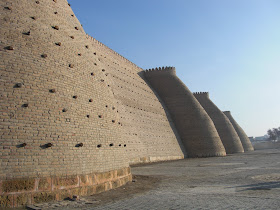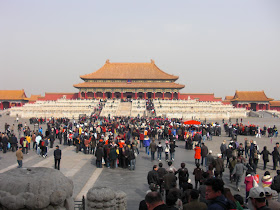"You can have results or excuses, not both..."
After a five hour drive, during which we saw the snow covered majestic mountain borders of Uzbekistan, we reached Samarkand. This hilly city is the second largest in Uzbekistan and is as old as Rome, Athens and Babylon. Situated on the Silk Road, ancient Arabs called it the “Gem of the East”, Europeans called it the “The Land of Scientists”. Ulugbhek built his observatory here and charted the stars even before astronomy was invented.
 |
| (Ulugbhek Observatory) |
Samarkand is the city of legends. When Alexander the Great saw Samarkand, he exclaimed “I heard that the city was beautiful but never thought that it could be so beautiful and majestic”. It’s also a city of love akin to Shakespeare’s tragic Romeo and Juliet but with Samar and Qand miraculously brought back to life at the end.
 |
| (A love story of Samar and Qand) |
One ancient poet wrote:
You can travel through the whole world, have a look at the pyramids and admire the smile of the Sphinx; You can listen to the soft singing of the wind at the Adriatic Sea and kneel down reverently at the ruins of the Acropolis, be dazzled by Rome with its Forum and Coliseum, be charmed by Notre Dame in Paris or by the old domes of Milan; But if you have seen buildings of Samarkanda, you will be enchanted by its magic forever....
 |
| (The mausoleum of Nabi Danial) |
It is believed that parts of Nabi Danial remains, namely a hand, were conveyed to Samarkand by Timur. A mausoleum was constructed over the burial place of this remains. Quite near to the mausoleum there is a spring with water considered sacred. The locals say that everyone wishing to visit this mausoleum should have a drink of this water and wash the open parts of their body. This is a place of pilgrimage for both local residents and international guests. In 1996, the Patriarch of All Russia Alexey II visited this mausoleum and sanctified it. The locals say, after sanctifying the mausoleum, a pistachio tree in the courtyard thought dead, began to blossom again.
 |
| (The Shah-i-Zinda Necropolis) |
In this city too, is situated one of the world’s notable architectural ensemble of the Samarkand, the Shah-i-Zinda necropolis. It’s also called the Street Of the Dead. Thirty five steps up leads to the eleven mausoleums. The most ancient is the ensemble of Kusam ibn-Abbas, a cousin of our revered prophet, Nabi Muhammad SAW. This ensemble is a monument of the warriors who charted world history. We ended the day at dusk at this beautiful ensemble to return to our hotel the Regal Palace.
 |
| (Memorial Complex of Imam al-Bukhari) |
Early next morning, we set off to the most famous attraction in Samarkand is the Imam al-Bukhari Memorial Complex which is located in Kharteng village, 12 kilometers from Samarkand. The complex includes mausoleums, mosques and administrative buildings.
The Imam al-Bukhari mausoleum is located in the center of this complex. This cubical building is crowned with a seventeen-meter dome. The right side door leads downstairs to a do dakhma, a place of worship. On the right side, under the sagana decorated with light blue onyx, there is a grave of Imam Al-Bukhari covered with marble.
 |
| (The original grave is underground) |
According to local historians, the present four side arched shaped building was constructed on top of the original grave of Imam Al Bukhari by the Uzbekistan government in 1997 while the Iranian government financed the project. Some lucky visitors had the opportunity to visit down to the actual grave. Unfortunately, we were not among those.
Muhammad Ibn Ismail Ibn Ibrahim Ibn al-Mughirah Ibn Bardizbah al-Bukhari popularly known as Imam Al Bukhari is best known for authoring the hadith collection of Sahih Bukhari, a collection which Sunni Muslims regard as the most authentic of all hadith compilations and the most authoritative book after the Qur'an. May God Bless the Imam. We thank God Almighty for giving us the opportunity to be here. Syukur Alhamdulillah.
 |
| (The marble tomb on top is only for display) |
On the left side of the inner yard there is a mosque that can accommodate 1500 people. The walls are decorated with light-green, blue and white glazed slabs, as well as with marble, onyx and granite; the floor with girikh. There is the Kiswah near the mihrab. This Ka’abah covering was presented to Uzbekistan by the king of Saudi Arabia.
About 1,000 visitors, including non-Muslims, from all over the world visit Imam Al-Bukhari's mausoleum every day.
 |
| (The Registan Square with three madrasah) |
Another magnificent landmark in this twenty five century old city, the Registan Square, a traditional centre of the city. The square is flanked on three sides by sparkling and turquoise tiled madrasahs, the Ulugbhek Madrasah, the Sherdor and the Tilla Qori. The interior and exterior facades of these buildings are decorated with ornaments of glazed brick, mosaic and carved marble. The Square is considered an architectural gem representing the finest in Islamic Art.
 |
| (The Mausoleum of Tamerlane) |
The Mausoleum of Tamerlane or Gur Emir is not far from the Registan. This famous blue ribbed cantaloupe dome of the mausoleum rises over the tin rooftops in central Samarkand. A massive slab of green jade, under which Tamerlane was laid is said to be the largest such stone in the world. Normally seen as black, it turns green when illuminated by the sun for lucky visitors. It was in its finest green during our visit.
 |
| (Bibi-Khanum Mosque) |
There is the fifteen century Bibi-Khanum Mosque, standing next to a noisy and crowded oriental market full of colourful fruits, vegetables and fragrant spices. Amir Timur dedicated this Bibi-Khanum Mosque to his wife and his victorious Indian Delhi campaign. It is said that he used elephants to haul the construction material. We had a short shopping stop here.
 |
| (A panting on the wall) |
Across the intersection from the market, the Hazrat-Hizr (Nabi Khidzir) Mosque occupies a hill on the fringes of Afrosiab. The eight century mosque that once stood here was burnt to the ground by Genghis Khan in the thirteenth century and was not rebuilt until 1854. In the 1990s it was lovingly restored by a wealthy Bukharan and today is Samarqand's most beautiful mosque, with a fine domed interior.





















































